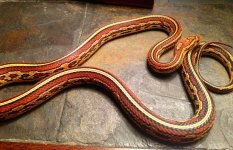Every motley baby produced from this pairing would be motley in phenotype only. Genetically speaking all the "motleys" would be het for both motley and stripe.
Seriously, I thought we had this figured out already. I can't believe people still don't understand this.
My thoughts exactly. There seems to be some confusion with the use of the term "homozygous" and the difference between the genotype and phenotype when you combine motley and stripe. When you breed a homozygous motley (
mm) to a homozygous stripe (
ss), ALL the offspring will be, genetically, "het motley het stripe" (
ms) since they only possess ONE copy of each, as are corns that are het motley (
Mm) and het stripe (
Ss).
Motley and stripe are similar to amel and ultra in that they sit at the same locus. However, while the phenotype of amel and ultra are both expressed in an ultramel, the phenotype of a motley/stripe (
ms) is only motley as the expression of the motley gene is dominant over the expression of the stripe gene, making it APPEAR that motley is in homozygous form when it actually is not.
The proof of the difference in genotype and phenotype is shown when you pair 2 motley/stripes (
ms) together:
mm (visual motley) X
ss (visual stripe) =
100%
ms (visual motley)
ms (visual motley) X
ms (visual motley) =
1/4
mm (visual motley)
1/2
ms (visual motley)
1/4
ss (visual stripe)
There is also confusion with the terms motley/stripe and striped motley. Some think they both refer to a snake that is genetically ms and use it that way, when I think striped motley is simply describing a pin-striped motley (versus a Q-tipped motley, a hurricane motley, etc) and motley/stripe is the genetic
ms. That is why some people use het motley het stripe to indicate the actual genetics, but that too can confuse some that don't realize the genes are alleles and indicate a snake with the phenotype expressed and not a normal pattern.
I do think that calling a ms corn "homo motley het stripe" is inaccurate as the snake is NOT homozygous motley and het stripe (
mmSs).


